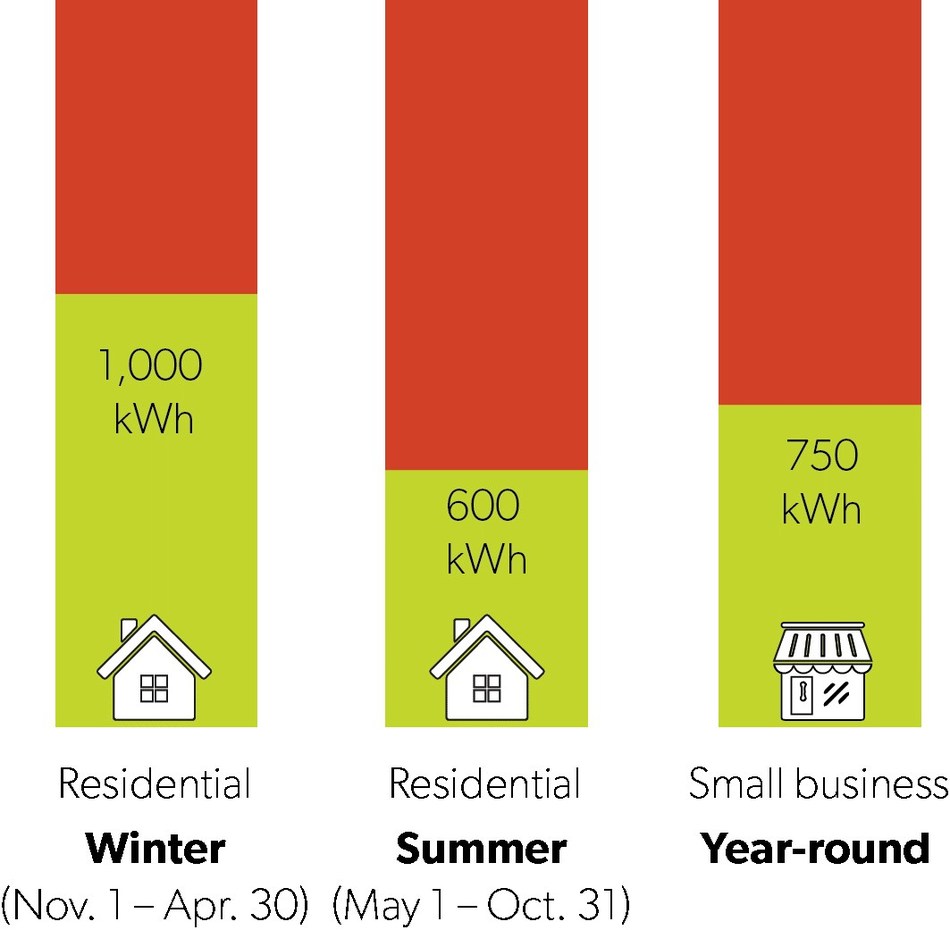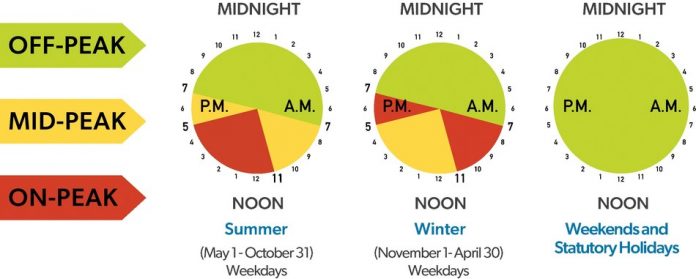The Ontario Energy Board announced new electricity prices for households and small businesses, effective Nov 1, under the Regulated Price Plan. The winter Time-of-Use hours and the winter Tier threshold for residential customers, which were maintained for the summer 2020 period, will remain in effect on Nov. 1.

The total bill for a typical residential customer who uses 700 kWh per month will increase by about $2.24 or 1.97%, after accounting for the bill relief provided by the Ontario Electricity Rebate (OER), a total (pre-tax) bill credit that appears at the bottom of electricity bills. The Ontario government has increased that rebate from 31.8% to 33.2% effective November 1, 2020.
The new TOU prices set by the OEB for November 1, 2020 are shown in the table below. The table also shows the hours to which those prices apply:
|
Winter TOU Price Periods |
November 1, 2020 TOU Prices |
|
Off-Peak |
10.5 ¢/kWh |
|
Mid-Peak |
15.0 ¢/kWh |
|
On-Peak |
21.7 ¢/kWh |
The table below shows the new prices for customers paying Tiered prices:
|
Winter Tier Thresholds |
November 1, 2020 Tiered Prices |
|
|
Tier 1 |
Residential – first 1,000 kWh/month Non-residential – first 750 kWh/month |
12.6 ¢/kWh |
|
Tier 2 |
Residential – for electricity used above 1,000 kWh/month Non-residential – for electricity used above 750 kWh/month |
14.6 ¢/kWh |
The total bill impact for individual customers across the province may vary depending on the customer’s electricity usage and the utility that serves them.
The OEB last set RPP prices in November 2019. The OEB is required by law to set RPP prices at least once every 12 months, and to set those prices to reflect the expected cost of supplying RPP customers. The increase in prices reflects a combination of factors, including those associated with the COVID-19 pandemic, that have affected demand, supply costs and prices in the summer and fall of 2020. When setting RPP prices, the OEB typically includes an amount to recover the entire difference between what RPP customers have paid for electricity since prices were last set and what the actual supply cost was over the same period. Given the impact on customers and ongoing uncertainty relating to COVID-19, the OEB decided that the difference should be recovered over a longer, two-year period. If the difference was recovered over one year, the electricity costs recovered through RPP prices would have been roughly 1.6% higher.
There are a number of programs in place to support electricity customers at this time, including:
- The OER, introduced in November 2019 by the Government of Ontario, provides a rebate on the pre-tax amount of the total bill.
- Support for residential, small business and charitable organization customers that are struggling to pay their energy bills as a result of the pandemic is available through the COVID-19 Energy Assistance Program and COVID-19 Energy Assistance Program for Small Business funded by the Government of Ontario.
- There are also a number of programs available to help low-income consumers. Find out more at oeb.ca/billhelp
In addition, the OEB has called on electricity distributors to focus efforts on promoting solutions for customers that have arrears and increasing awareness of support that may be available to customers.
Winter TOU Hours in effect November 1, 2020 to April 30, 2021
With Tiered prices, customers can use a certain amount of electricity each month at a lower price. Once that limit (called a threshold) is exceeded, a higher price applies. Although May to October 2020 has again been an exception due to COVID-19, for residential customers, the threshold normally changes with the season to reflect changing usage patterns – for example, there are fewer hours of daylight in the winter and some customers use electric heating.
In the winter period (November 1 – April 30), the Tier threshold for residential customers is 1,000 kWh, so that households can use more power at the lower price. In the summer period (May 1 – October 31), the Tier threshold for residential customers is 600 kWh. The Tier threshold for small business customers is 750 kWh all year round.
Understanding electricity bills
Electricity prices are shown on the Electricity line of the bill. This is the cost of the electricity used in the customer’s home or small business, and also includes the cost of some conservation programs.
Electricity distributors deliver this power to their customers’ homes and businesses, but they are not allowed to earn any profit from the sale of electricity. Electricity distributors, like Alectra Utilities Corporation or Hydro Ottawa Limited, and electricity transmitters, like Hydro One Networks Inc., recover their operating costs and an appropriate level of return through charges that are approved by the OEB and appear on the Delivery line of their customers’ bills. Visit our Understanding your electricity bill page for a more detailed explanation of the different line items on electricity bills.
Setting TOU and Tiered prices
The OEB sets both TOU and Tiered prices under the RPP. The RPP is designed to provide stable pricing, encourage conservation and ensure that the price customers pay for electricity better reflects the price paid to generators that produce the electricity that they use in their homes or small businesses.
As a result of the Covid-19 pandemic the OEB determined that it would not change prices for May 2020. The last RPP price setting was therefore November 2019. The OEB is required by law to set RPP prices at least once every 12 months, and to set those prices to reflect the expected cost of supplying RPP consumers. The RPP prices set for November 1, 2020 therefore reflect the forecast cost of supplying RPP consumers.
TOU and Tiered prices are set based on a 12-month forecast of how much it will cost to supply RPP customers with the electricity they are expected to use over the next 12 months. TOU and Tiered prices are set so that both recover the same forecast average cost of supply for a typical consumer.
Since RPP prices are based on a forecast, it is often the case that the prices RPP consumers have paid over a given period of time are different than the actual cost of the power supplied to them over the same period. To account for that, the OEB includes adjustments when it resets prices so that differences can be made up over time.
Changes to electricity pricing during COVID-19
On March 24, 2020, the Government of Ontario fixed the electricity price for TOU customers on the RPP at the off-peak price of 10.1 ¢/kWh for all hours of the day. This emergency measure supported residential and small business customers and farms at the start of the COVID-19 pandemic. This emergency pricing was initially set to expire on May 7, 2020, but the government announced on May 6, that the pricing would be extended to May 31, 2020.
On April 14, 2020, the OEB announced that it would defer setting new prices for households and small businesses under the RPP. The OEB also kept the winter TOU price periods and the winter residential Tier threshold in place to provide greater price stability for customers when they were staying at home. By keeping the winter Tier threshold in place, residential customers on Tiered pricing had an additional 400kWh/month available at the lower price. For customers on TOU pricing, keeping the winter TOU price periods in place meant that the mid-peak rather than the higher on-peak price applied in the afternoons (11 a.m.-5 p.m.), which can be a time of high electricity use for customers at home.
On June 1, 2020, the Government of Ontario fixed the electricity price for TOU customers on the RPP at 12.8 ¢/kWh for all hours of the day for TOU customers, to support them while Ontario planned for the safe and gradual reopening of the province. That pricing is expected to continue until October 31, 2020.
Reasons for the November 1 price change
There are two main factors contributing to the increase in the cost to supply electricity to RPP customers.
- First, the COVID-19 pandemic has resulted in changes to demand. As a result of declining demand in certain sectors, there is less consumption over which to spread costs and RPP customers’ share of the Global Adjustment has increased.
- Second, also as a result of the decline in demand and the prevailing electricity prices in effect over the summer and fall of 2020, there has been an increasing shortfall that needs to be recovered. Given this special circumstance, the OEB has decided to spread collection of this shortfall over two years to ease the impact on consumers. If the collection had been spread over 12 months as is typically the case, the electricity costs recovered through RPP prices would have been roughly 1.6% higher.
The supply cost estimate also reflects increases to nuclear and hydroelectric generation rates and higher revenues for Ontario Power Generation Inc.’s (OPG) nuclear generation due to changes in the Darlington refurbishment schedule. However, these cost increases are offset by lower payments for Bruce Power’s nuclear generation as a result of the Bruce Power unit 6 refurbishment, and lower conservation and demand management costs due to government policy changes.
TOU customers now have a choice of pricing plans
Residential or small business customers paying TOU prices can choose to switch to Tiered prices. Customers that want to stay on TOU pricing do not need to do anything.








